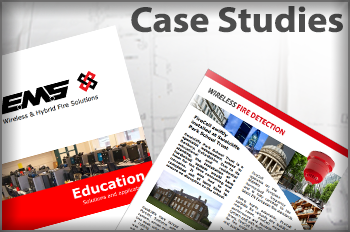Fire Systems Explained
An EMS wireless fire system uses wireless signals to connect devices, such as detectors and manual call points, instead of fire-resistant cable. All current fire standards, codes of practice and legislation remain the same, no change.
For many years the default was cable, as this was the only technology available. However, EMS who were at the forefront of wireless technology for high security systems in the banking industry decided to invest in fire system, cable-free development.
EMS pioneered and launched one of the earliest, and most successful wireless based systems in the early 1990’s, System 5000. This proved to be a huge success and benefited heritage properties, and those that could not have cable installed for many challenging reasons, yet were required to have a fire system to meet safety and legislation requirements.
The gamechanger was the introduction of EN54-25, a pan European standard that changed the entire landscape of wireless fire detection. As a life safety system, it’s imperative that any wireless system is reliable and trustworthy. EN54-25 was drafted to ensure this was the case, with very specific direction on how a fire system had to comply and be certified across its entire product range. This EN54-25 is in addition to specific EN standards applicable to each fire product e.g. A wireless manual call point would need both EN54-25 and EN54-11.
This European standard was introduced to ensure that a wireless system would be as good, or better, than a wired system. It has many requirements that manufacturers and wireless fire system developers must meet, before a system can be certified and introduced on to the market.
EN54-25 stipulates that reliability is key, and technological developments to meet the standard are achieved in different ways, with the overriding factor being full compliance with the standard. Wireless signals from fire devices to panels must be bi-directional, ensuring a constant and robust “handshake” and therefore, 100% connectivity always, as if it were connected with cable.
The overarching consequence of the standard is encapsulated in the following paragraph:
“The aim of part25 is to define additional requirements to other parts of EN 54 and tests that allow radio fire detection systems and components complying with them to be as efficient and stable as wired fire detection systems and components complying with the current requirements of cable-based systems in the EN 54 standards”.
EMS FireCell was the first fully certified EN54-25 fire detection system to be launched and has since gone through many updates and additions to the platform, making it the most trusted, flexible and reliable wireless system available today.
System Design
Many questions are asked, whenever wireless technology is discussed, how to design a fire system using this technology? What specific changes are needed to meet BS5839 criteria? These are just two examples.
These are usually very simple to answer, as the design and type of system specified remains the same. If it’s a Category P, Category L or Category M System, then it’s designed to meet that specification. The only thing that is different, is that there is no cable.
Are the fire devices any different? Are the detectors special? Will the fire panel confuse users? These are further questions often raised, but other than having wireless embedded into the actual devices everything looks, feels and acts the same as any other EN54 approved fire device. True, we believe EMS products are better and more reliable, and you may well recognise many, as we also use the popular and respected XP95 protocol as part of FireCell system infrastructure.
Using the highly robust and secure 868MHz frequency (not wi-fi!) each fire device constantly communicates with the control panel, and the panel with each device. Effectively the same as if it was connected with a piece of cable. The difference is that the time and cost of installing that cable is now saved. All the cable containment is also removed, as is any breaching of fire compartments. Another huge advantage is that décor and building fabric is unaffected making for a very happy building owner.
All the rules on zoning, device location and timings remain the same, as does the methodology around system configuration and any local “cause and effect”.
The one caveat with wireless is to have a wireless survey carried out, and EMS provide this as a FREE service. This ensures that signal levels across the property meet EN54-25 requirements, other than that, its that simple, just no cable.
Unless of course you want to mix existing cable and wireless to have a hybrid fire detection system, that’s easily achieved as well.
In conclusion
EN standards are in place to guarantee compliance with the high standards set by the fire industry. An EN54-25 certification is your assurance that wireless is every bit as good as using cable, or even better, it has to be.
Choosing wireless is a therefore more about ease of installation, speed of installation and in most cases, saving in monetary terms as well. If you want to know more about where EMS wireless fire detection is being used, and see specific examples of FireCell installations, please read/download our FREE case study publication.




